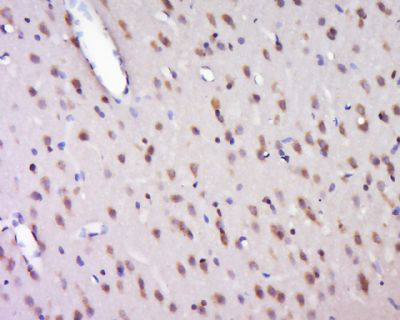产品货号 : mlR15450
英文名称 : HELZ
中文名称 : 人肿瘤抑制蛋白抗体
别 名 : DKFZp586G1924; Down regulated in human cancers; DRHC; Helicase with zinc finger; HUMORF 5; HUMORF5; KIAA0054; MGC163454; Probable helicase with zinc finger domain; HELZ_HUMAN.
研究领域 : 细胞生物 免疫学 染色质和核信号 表观遗传学
抗体来源 : Rabbit
克隆类型 : Polyclonal
交叉反应 : Human, Mouse, Rat,
产品应用 : ELISA=1:500-1000 IHC-P=1:400-800 IHC-F=1:400-800 Flow-Cyt=1μg/Test ICC=1:100-500 IF=1:100-500 (石蜡切片需做抗原修复)
not yet tested in other applications.
optimal dilutions/concentrations should be determined by the end user.
分 子 量 : 219kDa
细胞定位 : 细胞核
性 状 : Lyophilized or Liquid
浓 度 : 1mg/ml
免 疫 原 : KLH conjugated synthetic peptide derived from human HELZ:1-100/1942
亚 型 : IgG
纯化方法 : affinity purified by Protein A
储 存 液 : 0.01M TBS(pH7.4) with 1% BSA, 0.03% Proclin300 and 50% Glycerol.
保存条件 : Store at -20 °C for one year. Avoid repeated freeze/thaw cycles. The lyophilized antibody is stable at room temperature for at least one month and for greater than a year when kept at -20°C. When reconstituted in sterile pH 7.4 0.01M PBS or diluent of antibody the antibody is stable for at least two weeks at 2-4 °C.
PubMed : PubMed
产品介绍 : Helicases comprise a class of enzymes that function as motor proteins which move along nucleic acid phosphodiester bonds, effectively separating two annealed nucleic acid strands. RNA helicases alter the conformation of RNA, specifically by unwinding double-stranded RNA regions to yield single RNA strands, a process which changes the biological activity of the RNA molecule. HELZ (helicase with zinc finger), also known as DHRC or HUMORF5, is a 1,942 amino acid nuclear protein that contains one C3H1-type zinc finger and belongs to the RNA helicase superfamily. Expressed ubiquitously during embryonic development, HELZ is thought to function as an RNA helicase that modifies RNA structure and plays a role in the development of multiple organs and tissues within the developing embryo.
Function:
May act as a helicase that plays a role in RNA metabolism in multiple tissues and organs within the developing embryo.
Subunit:
Interacts with SMYD2 (By similarity). Interacts with POLR2A. Interacts with SMYD3; the interaction may bridge SMYD3 and RNA polymerase II.
Subcellular Location:
Nucleus (Probable).
Tissue Specificity:
Expressed predominantly in thymus and brain. Expression is down-regulated in 28 of 95 tested cancer cell lines.
Similarity:
Belongs to the DNA2/NAM7 helicase family.
Contains 1 C3H1-type zinc finger.
SWISS:
P42694
Gene ID:
9931
Important Note:
This product as supplied is intended for research use only, not for use in human, therapeutic or diagnostic applications.
产品图片












